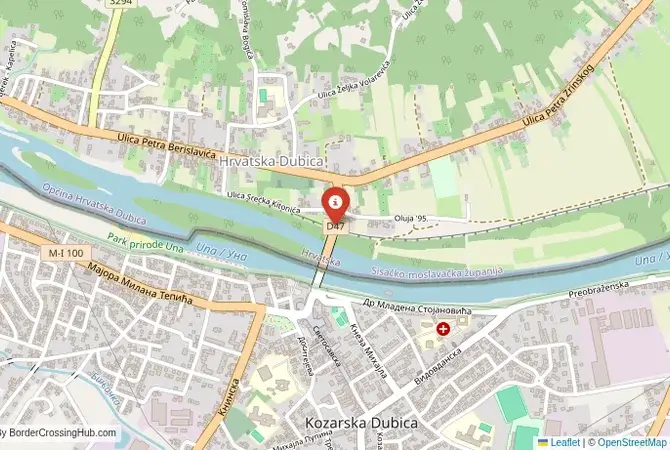
Approximate Border Location
Border Countries
Border Cities
- 🇭🇷Hrvatska Dubica
- 🇧🇦Kozarska Dubica
Wait Times
30-90 min for pedestrians/vehicles
Operating Hours
Open 24 hours
Crossing Types
Pedestrians, vehicles, commercial
Border Type
Land crossing via road
Peak Times
Mornings (7-10 AM), weekends
Daily Crossings
~4000 travelers/vehicles
Currency Exchange
Available near Kozarska (BAM, EUR)
Safety Information
Busy, minimal crime
Languages Spoken
Bosnian/Croatian
Accessibility Features
Ramps, elevators
About Hrvatska Dubica & Kozarska Dubica
A Crossing Through a Divided Town
The border crossing connecting the town of Kozarska Dubica in Bosnia and Herzegovina with Hrvatska Dubica in Croatia is a journey through what was once a single, unified market town. This is a local checkpoint, a bridge over the Una River that serves primarily the needs of the local communities. Since Croatia is a member of the European Union and the Schengen Area, this is an external border. To cross here is to travel through a landscape with a deep, complex, and often tragic shared history, a passage that highlights the human consequences of borders that divide communities. It is a quiet crossing, but one that is laden with the memory of the conflicts of the 20th century.
Operational Details
This checkpoint connects the Kozarska Dubica Municipality of Bosnia and Herzegovina (within the Republika Srpska entity) with Sisak-Moslavina County of Croatia. It is a smaller international crossing, open 24/7, but with restrictions on heavy freight traffic. It is intended primarily for passenger cars and local traffic. The crossing is on a bridge that connects the centers of the two towns. The former border posts are still very much in evidence, and the process involves stopping on both sides of the river. The traffic is generally light, making it a relatively quick and uncomplicated crossing.
Before Crossing
Crossing borders gets messy sometimes, think political flare-ups or gates shutting fast. Good travel insurance is a must for handling doctor visits, trip disruptions, or security scares. Don’t get caught unprepared. To find a policy that’s got your back, check out reliable plans today for peace of mind.
A History of a Military Frontier and a Divided Town
The history of this region is the history of the “Military Frontier,” a heavily fortified borderland created by the Habsburg Empire to defend against the Ottoman Empire. The Una River was a key part of this frontier for centuries. The town of Dubica was a strategic fortress. After the end of the Ottoman-Habsburg wars, the town grew as a single entity. The modern border, established after the breakup of Yugoslavia, divided the town. The larger, more developed part became Kozarska Dubica in Bosnia, while the smaller, historic part became Hrvatska Dubica in Croatia. The area was also the scene of intense fighting during the Bosnian War and the Croatian War of Independence in the 1990s. The bridge was destroyed and has since been rebuilt.
The Schengen Border Procedure
The border crossing procedure is a rigorous process, reflecting its status as an entry point into the EU and the Schengen Area. You will first complete exit formalities at the Bosnian checkpoint in Kozarska Dubica. After crossing the bridge, you will arrive at the Croatian checkpoint in Hrvatska Dubica for a full EU/Schengen entry inspection by the Croatian Border Police and Customs. You will need a valid passport. National ID cards are only sufficient for EU citizens. Vehicle registration and international insurance (Green Card) are also necessary. As a smaller crossing, the process is generally faster than at the main highways, but the checks are still thorough.
The Surrounding Region: Bosnia and Herzegovina Side
On the Bosnian side, Kozarska Dubica is a pleasant town on the banks of the Una River. The crossing is the gateway to the magnificent Kozara National Park, a forested mountain famous as a World War II partisan stronghold. A monumental memorial complex on the mountain’s summit commemorates the brutal Battle of Kozara in 1942. The park is now a popular destination for hiking and recreation. The nearby city of Prijedor is a major regional center.
The Surrounding Region: Croatia Side
On the Croatian side, Hrvatska Dubica is a small, quiet town. The crossing is in the historic region of Banovina, an area that was heavily affected by the Croatian War of Independence. The region is known for its beautiful, rolling hills and its rural scenery. The crossing is also a gateway to the Lonjsko Polje Nature Park, one of the largest protected wetlands in Europe, famous for its traditional wooden houses and its rich birdlife. The Jasenovac Memorial Site, a powerful and somber monument to the victims of the World War II concentration camp, is also in this region.
Practical Travel Information
Practical planning for this route is straightforward. The roads leading to the crossing are regional and well-maintained. The official currencies are the Bosnian Convertible Mark (BAM) in Bosnia and Herzegovina and the Euro (EUR) in Croatia. Services are available in the towns on both sides of the border. Ensure your vehicle’s Green Card insurance is valid for both countries. This crossing can be a good alternative to the busier crossing at Gradiška, especially for those traveling between the Banja Luka and Zagreb regions.
Final Considerations
The Kozarska Dubica–Hrvatska Dubica border crossing is a journey through a landscape of deep and often painful history. It is a quiet, functional checkpoint that serves as a vital link for the two halves of a divided town. It offers a passage through a region of great natural beauty, from the heroic mountains of Kozara to the peaceful wetlands of Lonjsko Polje. It is a border that is a testament to the resilience of the local communities and a poignant reminder of the complex history of the Sava and Una river valleys.
See other crossings between Bosnia and Herzegovina and Croatia
See other crossings between Bosnia and Herzegovina and Croatia
No reviews yet.
